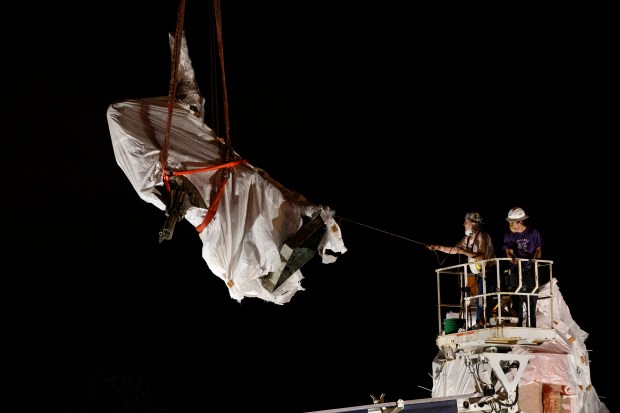Mayor Brandon Johnson defended the decision Tuesday to permanently remove Christopher Columbus statues from two Chicago parks as an effort to show “our collective humanity.”
The Grant Park and Arrigo Park Columbus statues have hung in political limbo since former Mayor Lori Lightfoot removed them amid protests in 2020.
But Johnson’s newly appointed Park District CEO, Carlos Ramirez-Rosa, announced a deal last week to loan the smaller statue, that had been in Arrigo Park, for a planned Italian immigrant museum and clear away the larger Grant Park statue’s base.
Asked about the long celebrated, but now more closely scrutinized Italian explorer’s legacy, Johnson Tuesday talked about the trans-Atlantic slave trade and decimation of indigenous American people that followed Columbus’s arrival. Still, Columbus left a legacy many are proud of, he added.
“Art and culture in particular is something that I don’t believe we should erase,” Johnson said. “And we do have to make sure that our presentation is depicting not just truth, but the best part of our existence, which is our collective humanity.”
The statue deal resolved a lawsuit filed by the Joint Civic Committee of Italian Americans over the Arrigo Park statue removal. But another community group, the Italian American Human Relations Foundation of Chicago, blasted the agreement to get the statue back as “cultural treason.”
The group’s president, Lou Rago, said the deal between the Park District and the JCCIA, which he was formerly president of, “is not a return,” but “a burial.”
“The statue will be hidden away indoors – out of public sight – as part of an undefined ‘museum-style’ exhibit,” Rago wrote. “A sad final disposition of a statue of the heroic navigator whose voyages led to the introduction of Western European civilization and culture to a new world.”
Ron Onesti, president of the JCCIA, which represents over 60 Italian-American organizations across the Chicago area, praised the deal last week as a “huge victory for our community, and to all those who believe in free speech and artistic expression.”
On Tuesday, he defended the deal as “what the community wants.”
“You have to understand the options,” Onesti said. “The city owns the statue and could have done anything. It could have been melted down to Columbus keychains.”
Onesti praised Johnson’s administration for discussing the statues, something he said former Mayor Lori Lightfoot’s team would not do. Safety issues were a key focus for the city in negotiations, he added.
The deal also gives JCCIA say in what statue honoring an Italian takes Columbus’s place in Arrigo Park. Onesti suggested Frances Xavier Cabrini, better known as “Mother Cabrini,” the Italian-born woman who became the first American to be named a saint and who died in Chicago. He hopes his organization can also someday get the Grant Park Columbus state to be put on display somewhere.
“Sure we want it back where it was,” he said. “But the world has changed quite a bit.”
Asked Tuesday about the difference between the removed Columbus statues and the controversial pro-Palestinian protest puppet his administration kept up at the Chicago Cultural Center in January, Johnson argued “there is a distinction between art and monument.”
“A monument solidifies a position… we are honoring,” he said. “Art is not necessarily telling you you should honor their opinion or their thought.”
Johnson praised the “healthy” debate around the statue plans. He welcomed a “larger circle or conversation about the historic harms that have been caused,” and said Chicago should rally around the story of its founding by a Black Haitian immigrant and a Pottawatomie woman.
The Park District announced it plans to use the freed up Grant Park space once the Columbus plinth is removed to “redesign the plaza as a gathering space that will accommodate temporary artworks.”
The statues were taken down amid bloody confrontations between police and protesters in 2020, and remained in storage while Lightfoot awaited a task force recommendation about what to do about those statues and others that were targeted by activists for honoring white supremacy or disrespecting Indigenous peoples. That report finally landed in 2022.
With the new deal, Johnson now holds responsibility for ending the long-running statue standoff. But despite the move, he argued the focus among Chicagoans should not be on “dividing lines” and urged focus on other issues facing the city.
“All of Chicago wants us to address homelessness. All of Chicago wants us to address housing. All of Chicago wants us to address violence in the city,” he said. “And that’s what we’re doing.”



